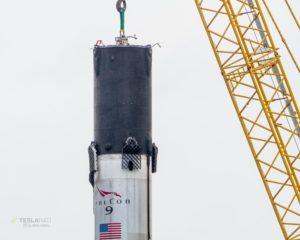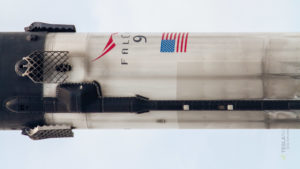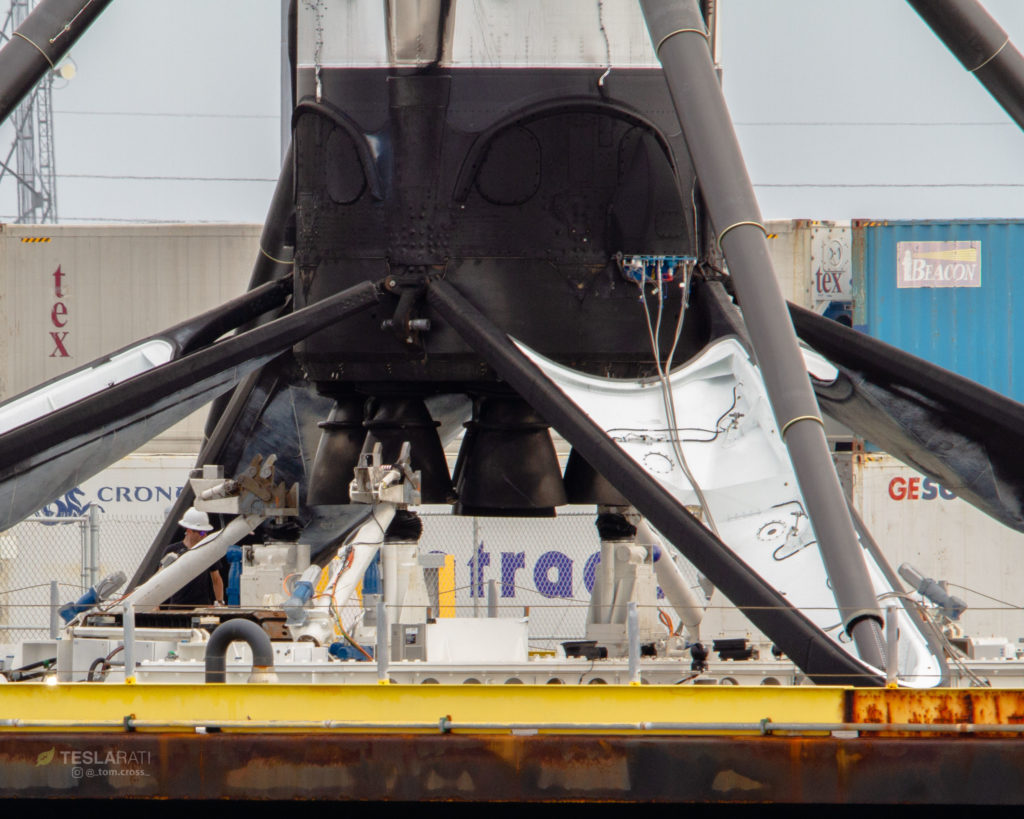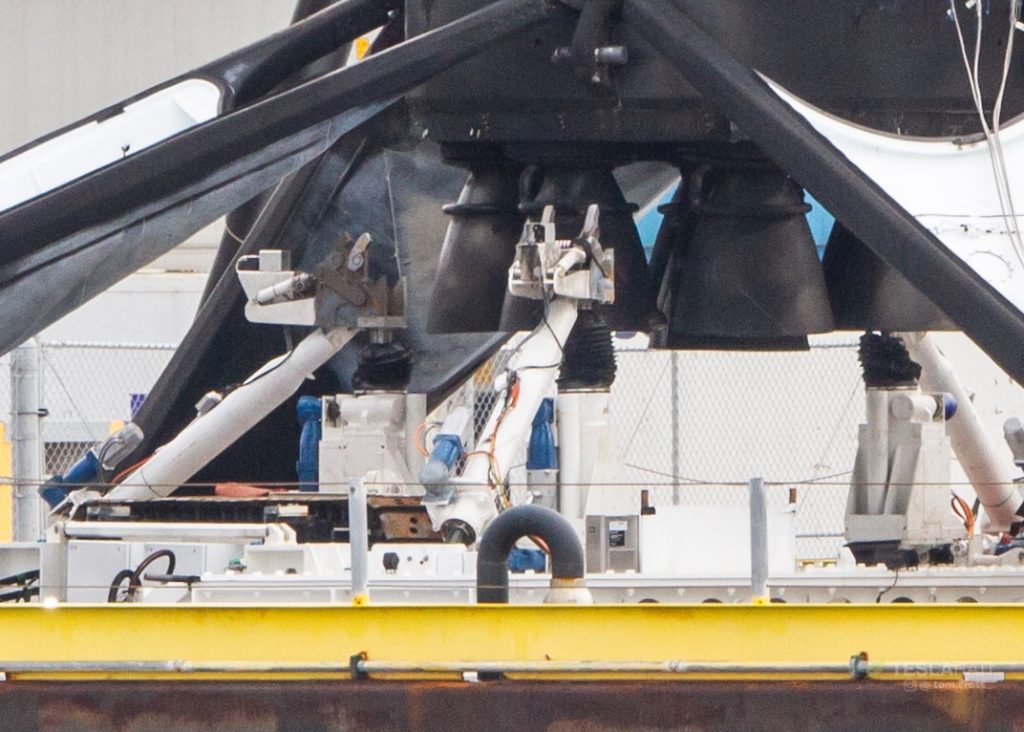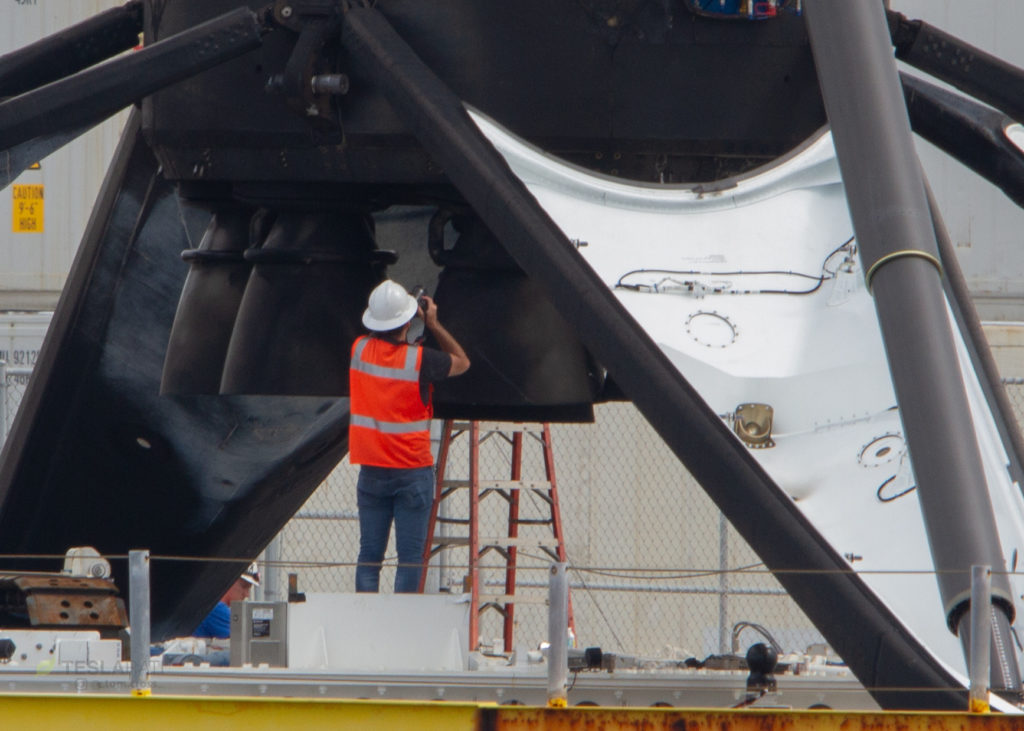
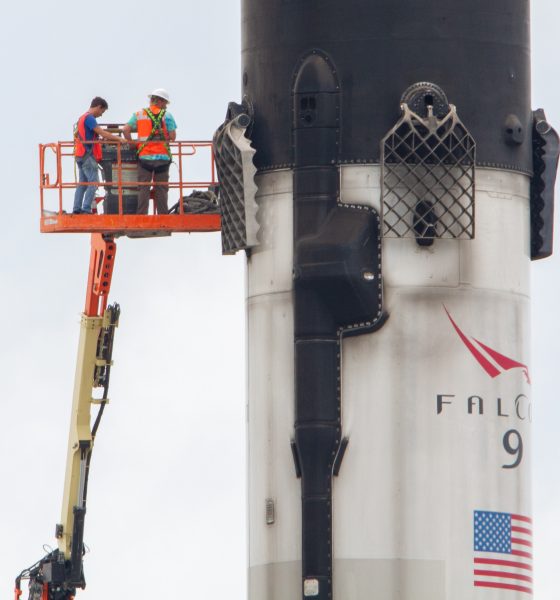
News
SpaceX’s first Falcon 9 Block 5 returns to port in pristine condition
SpaceX’s first launched and landed Falcon 9 Block 5 booster has returned to port after a handful of days at sea, hopefully marking the beginning of a long and storied future of commercial missions. The booster – numbered B1046 – appears to be in extraordinarily good shape, more or less unscathed after a relatively high-energy reentry. Photographer Tom Cross documented the historic return in person at Port Canaveral.
After detaching from the rocket’s second stage, which went on to successfully inject Bangladesh’s first communications satellite into a geostationary transfer orbit, B1046 reached a peak of around 110 km before reentering Earth’s atmosphere. Traveling 2 kilometers (1.2 miles) per second, Block 5 eventually completed a soft landing 500 miles off the Florida coast on the drone ship Of Course I Still Love You. The 25th successful Falcon 9 booster recovery, B1046 marked that historic achievement in proper style, dressed with large, black sections of the new SpaceX-developed thermal protection system, among dozens of other major improvements included in the launch vehicle’s “Block” upgrade.
- Technicians attach an older interstage-grabber to lift B1046 after its first recovery. (Tom Cross)
- SpaceX’s first successfully launched and landed Block 5 Falcon 9, May 2018. (Tom Cross)
- The central aluminum grid fin of 1029 features a dramatic lack of several vanes, likely melted off during the intense heat of reentry. (Reddit, u/thedubya22)
- B1046 returned to Port Canaveral shortly after its May 4 debut, and is now being carefully analyzed as pathfinder hardware. (Tom Cross)
While not visible, the most significant improvements are likely to be found at the base of the first stage’s octaweb – now assembled with bolts instead of welds – in the form of a dramatically improved heat shield around its nine Merlin 1D engines (also upgraded, of course). One of the Falcon recovery technicians showed some exceptional interest in the shield and Merlins, likely documenting their condition in extreme detail to inform engineering reviews of the pathfinder rocket after its first flight test. Per CEO Elon Musk’s pre-launch phone call with members of the press, SpaceX means to do an extremely thorough disassembly and analysis of B1046 in order to (hopefully) validate many thousands of hours of design, engineering, modeling, and testing. If those reviews are promising, it’s extremely likely that B1046 will be reassembled and flown many more times, perhaps one day becoming another historic monument to SpaceX’s reusability program and Block 5 upgrade.
- A technician examines the booster’s brand-new leg retraction mechanism, likely to be operationally trialed for the first time sometime today or tomorrow. (Tom Cross)
- Octagrabber hangs on to B1046 as OCISLY arrives in port. (Tom Cross)
- (Tom Cross)
- A SpaceX technician spied taking photos of the Block 5 rocket’s Merlin engines and octaweb heatshield. (Tom Cross)
Meanwhile, this mission also marked another routine operation for SpaceX’s robotic stage-securing robot, unofficially nicknamed Roomba or Octagrabber. This custom-built robot is used to better ensure the safety of SpaceX’s recovery crew by allowing them to remain on an accompanying vessel while securing the booster robotically, significantly lowering the chances of it sliding around or tipping over in high sea states.

News
Tesla starts showing how FSD will change lives in Europe
Local officials tested the system on narrow country roads and were impressed by FSD’s smooth, human-like driving, with some calling the service a game-changer for everyday life in areas that are far from urban centers.

Tesla has launched Europe’s first public shuttle service using Full Self-Driving (Supervised) in the rural Eifelkreis Bitburg-Prüm region of Germany, demonstrating how the technology can restore independence and mobility for people who struggle with limited transport options.
Local officials tested the system on narrow country roads and were impressed by FSD’s smooth, human-like driving, with some calling the service a game-changer for everyday life in areas that are far from urban centers.
Officials see real impact on rural residents
Arzfeld Mayor Johannes Kuhl and District Administrator Andreas Kruppert personally tested the Tesla shuttle service. This allowed them to see just how well FSD navigated winding lanes and rural roads confidently. Kruppert said, “Autonomous driving sounds like science fiction to many, but we simply see here that it works totally well in rural regions too.” Kuhl, for his part, also noted that FSD “feels like a very experienced driver.”
The pilot complements the area’s “Citizen Bus” program, which provides on-demand rides for elderly residents who can no longer drive themselves. Tesla Europe shared a video of a demonstration of the service, highlighting how FSD gives people their freedom back, even in places where public transport is not as prevalent.
What the Ministry for Economic Affairs and Transport says
Rhineland-Palatinate’s Minister Daniela Schmitt supported the project, praising the collaboration that made this “first of its kind in Europe” possible. As per the ministry, the rural rollout for the service shows FSD’s potential beyond major cities, and it delivers tangible benefits like grocery runs, doctor visits, and social connections for isolated residents.
“Reliable and flexible mobility is especially vital in rural areas. With the launch of a shuttle service using self-driving vehicles (FSD supervised) by Tesla in the Eifelkreis Bitburg-Prüm, an innovative pilot project is now getting underway that complements local community bus services. It is the first project of its kind in Europe.
“The result is a real gain for rural mobility: greater accessibility, more flexibility and tangible benefits for everyday life. A strong signal for innovation, cooperation and future-oriented mobility beyond urban centers,” the ministry wrote in a LinkedIn post.
News
Tesla China quietly posts Robotaxi-related job listing
Tesla China is currently seeking a Low Voltage Electrical Engineer to work on circuit board design for the company’s autonomous vehicles.

Tesla has posted a new job listing in Shanghai explicitly tied to its Robotaxi program, fueling speculation that the company is preparing to launch its dedicated autonomous ride-hailing service in China.
As noted in the listing, Tesla China is currently seeking a Low Voltage Electrical Engineer to work on circuit board design for the company’s autonomous vehicles.
Robotaxi-specific role
The listing, which was shared on social media platform X by industry watcher @tslaming, suggested that Tesla China is looking to fill the role urgently. The job listing itself specifically mentions that the person hired for the role will be working on the Low Voltage Hardware team, which would design the circuit boards that would serve as the nervous system of the Robotaxi.
Key tasks for the role, as indicated in the job listing, include collaboration with PCB layout, firmware, mechanical, program management, and validation teams, among other responsibilities. The role is based in Shanghai.
China Robotaxi launch
China represents a massive potential market for robotaxis, with its dense urban centers and supportive policies in select cities. Tesla has limited permission to roll out FSD in the country, though despite this, its vehicles have been hailed as among the best in the market when it comes to autonomous features. So far, at least, it appears that China supports Tesla’s FSD and Robotaxi rollout.
This was hinted at in November, when Tesla brought the Cybercab to the 8th China International Import Expo (CIIE) in Shanghai, marking the first time that the autonomous two-seater was brought to the Asia-Pacific region. The vehicle, despite not having a release date in China, received a significant amount of interest among the event’s attendees.
Elon Musk
Elon Musk and Tesla AI Director share insights after empty driver seat Robotaxi rides
The executives’ unoccupied tests hint at the rapid progress of Tesla’s unsupervised Robotaxi efforts.

Tesla CEO Elon Musk and AI Director Ashok Elluswamy celebrated Christmas Eve by sharing personal experiences with Robotaxi vehicles that had no safety monitor or occupant in the driver’s seat. Musk described the system’s “perfect driving” around Austin, while Elluswamy posted video from the back seat, calling it “an amazing experience.”
The executives’ unoccupied tests hint at the rapid progress of Tesla’s unsupervised Robotaxi efforts.
Elon and Ashok’s firsthand Robotaxi insights
Prior to Musk and the Tesla AI Director’s posts, sightings of unmanned Teslas navigating public roads were widely shared on social media. One such vehicle was spotted in Austin, Texas, which Elon Musk acknowleged by stating that “Testing is underway with no occupants in the car.”
Based on his Christmas Eve post, Musk seemed to have tested an unmanned Tesla himself. “A Tesla with no safety monitor in the car and me sitting in the passenger seat took me all around Austin on Sunday with perfect driving,” Musk wrote in his post.
Elluswamy responded with a 2-minute video showing himself in the rear of an unmanned Tesla. The video featured the vehicle’s empty front seats, as well as its smooth handling through real-world traffic. He captioned his video with the words, “It’s an amazing experience!”
Towards Unsupervised operations
During an xAI Hackathon earlier this month, Elon Musk mentioned that Tesla owed be removing Safety Monitors from its Robotaxis in Austin in just three weeks. “Unsupervised is pretty much solved at this point. So there will be Tesla Robotaxis operating in Austin with no one in them. Not even anyone in the passenger seat in about three weeks,” he said. Musk echoed similar estimates at the 2025 Annual Shareholder Meeting and the Q3 2025 earnings call.
Considering the insights that were posted Musk and Elluswamy, it does appear that Tesla is working hard towards operating its Robotaxis with no safety monitors. This is quite impressive considering that the service was launched just earlier this year.

